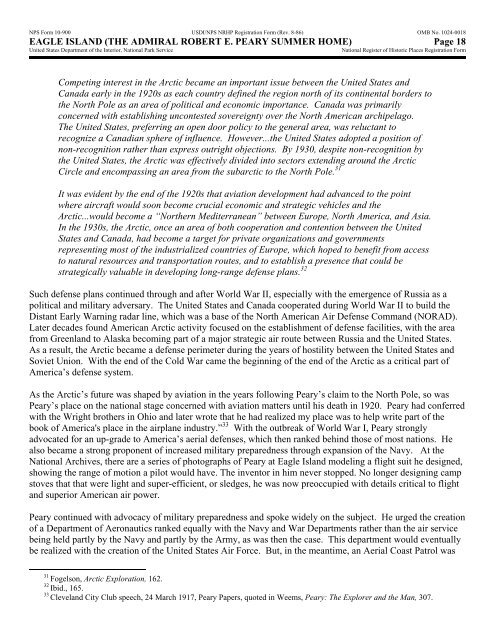Nomination - National Park Service
Nomination - National Park Service
Nomination - National Park Service
You also want an ePaper? Increase the reach of your titles
YUMPU automatically turns print PDFs into web optimized ePapers that Google loves.
NPS Form 10-900 USDI/NPS NRHP Registration Form (Rev. 8-86) OMB No. 1024-0018<br />
EAGLE ISLAND (THE ADMIRAL ROBERT E. PEARY SUMMER HOME) Page 18<br />
United States Department of the Interior, <strong>National</strong> <strong>Park</strong> <strong>Service</strong><br />
<strong>National</strong> Register of Historic Places Registration Form<br />
Competing interest in the Arctic became an important issue between the United States and<br />
Canada early in the 1920s as each country defined the region north of its continental borders to<br />
the North Pole as an area of political and economic importance. Canada was primarily<br />
concerned with establishing uncontested sovereignty over the North American archipelago.<br />
The United States, preferring an open door policy to the general area, was reluctant to<br />
recognize a Canadian sphere of influence. However...the United States adopted a position of<br />
non-recognition rather than express outright objections. By 1930, despite non-recognition by<br />
the United States, the Arctic was effectively divided into sectors extending around the Arctic<br />
Circle and encompassing an area from the subarctic to the North Pole. 31<br />
It was evident by the end of the 1920s that aviation development had advanced to the point<br />
where aircraft would soon become crucial economic and strategic vehicles and the<br />
Arctic...would become a “Northern Mediterranean” between Europe, North America, and Asia.<br />
In the 1930s, the Arctic, once an area of both cooperation and contention between the United<br />
States and Canada, had become a target for private organizations and governments<br />
representing most of the industrialized countries of Europe, which hoped to benefit from access<br />
to natural resources and transportation routes, and to establish a presence that could be<br />
strategically valuable in developing long-range defense plans. 32<br />
Such defense plans continued through and after World War II, especially with the emergence of Russia as a<br />
political and military adversary. The United States and Canada cooperated during World War II to build the<br />
Distant Early Warning radar line, which was a base of the North American Air Defense Command (NORAD).<br />
Later decades found American Arctic activity focused on the establishment of defense facilities, with the area<br />
from Greenland to Alaska becoming part of a major strategic air route between Russia and the United States.<br />
As a result, the Arctic became a defense perimeter during the years of hostility between the United States and<br />
Soviet Union. With the end of the Cold War came the beginning of the end of the Arctic as a critical part of<br />
America’s defense system.<br />
As the Arctic’s future was shaped by aviation in the years following Peary’s claim to the North Pole, so was<br />
Peary’s place on the national stage concerned with aviation matters until his death in 1920. Peary had conferred<br />
with the Wright brothers in Ohio and later wrote that he had realized my place was to help write part of the<br />
book of America's place in the airplane industry.” 33 With the outbreak of World War I, Peary strongly<br />
advocated for an up-grade to America’s aerial defenses, which then ranked behind those of most nations. He<br />
also became a strong proponent of increased military preparedness through expansion of the Navy. At the<br />
<strong>National</strong> Archives, there are a series of photographs of Peary at Eagle Island modeling a flight suit he designed,<br />
showing the range of motion a pilot would have. The inventor in him never stopped. No longer designing camp<br />
stoves that that were light and super-efficient, or sledges, he was now preoccupied with details critical to flight<br />
and superior American air power.<br />
Peary continued with advocacy of military preparedness and spoke widely on the subject. He urged the creation<br />
of a Department of Aeronautics ranked equally with the Navy and War Departments rather than the air service<br />
being held partly by the Navy and partly by the Army, as was then the case. This department would eventually<br />
be realized with the creation of the United States Air Force. But, in the meantime, an Aerial Coast Patrol was<br />
31<br />
Fogelson, Arctic Exploration, 162.<br />
32<br />
Ibid., 165.<br />
33<br />
Cleveland City Club speech, 24 March 1917, Peary Papers, quoted in Weems, Peary: The Explorer and the Man, 307.
















